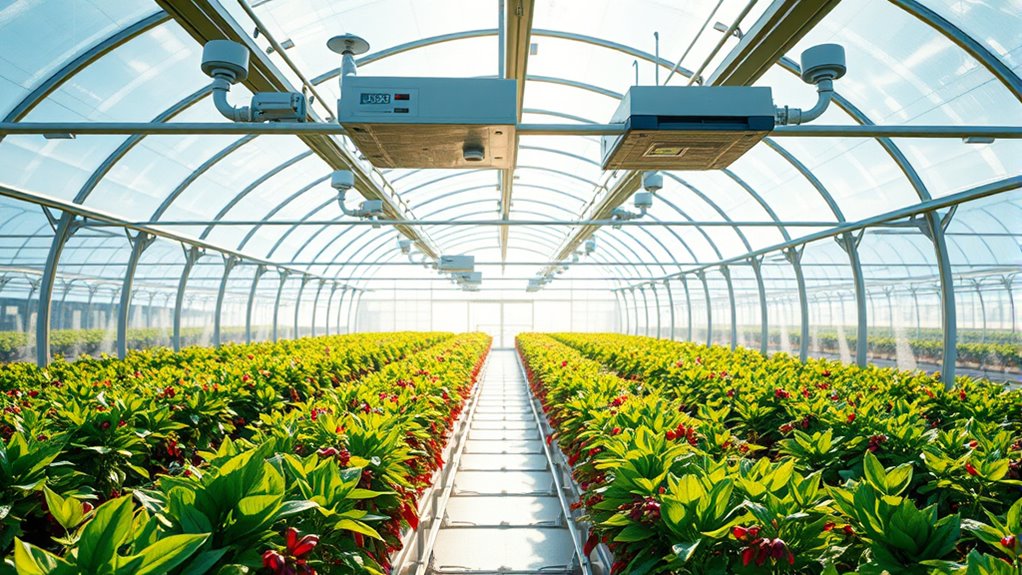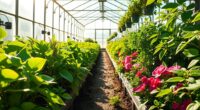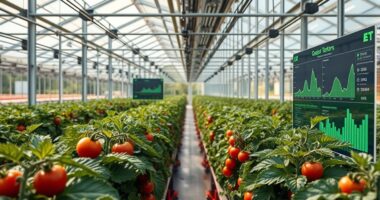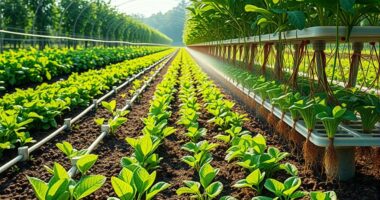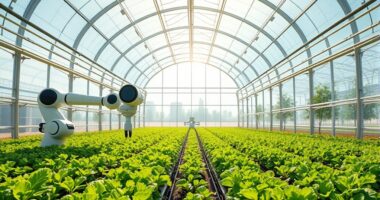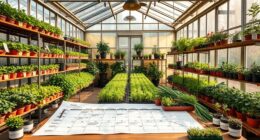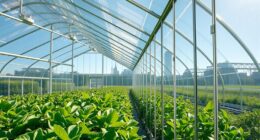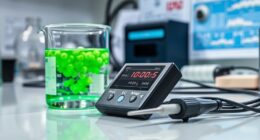Automated climate control systems for greenhouses help you optimize temperature, humidity, and CO2 levels, ensuring healthier plants and higher yields. By utilizing sensors, controllers, and actuators, you can maintain consistent conditions that reduce plant stress and improve disease resistance. Plus, automation saves you time and labor, allowing for efficient resource use and cost savings. With advanced features, you can take your greenhouse management to the next level. Discover more about enhancing your greenhouse efficiency.
Key Takeaways
- Automated climate control systems utilize sensors to monitor and manage temperature, humidity, and CO2 levels for optimal plant growth.
- Controllers and software provide real-time data processing, allowing for precise adjustments and reducing human error in greenhouse management.
- Energy-efficient technologies, such as renewable energy sources and LED lighting, help lower operational costs and reduce environmental impact.
- Consistent environmental conditions lead to healthier plants, increased disease resistance, and improved yields through enhanced photosynthesis.
- Remote access features enable growers to oversee and adjust greenhouse conditions from anywhere, streamlining operations and increasing efficiency.
System Components of Automated Climate Control
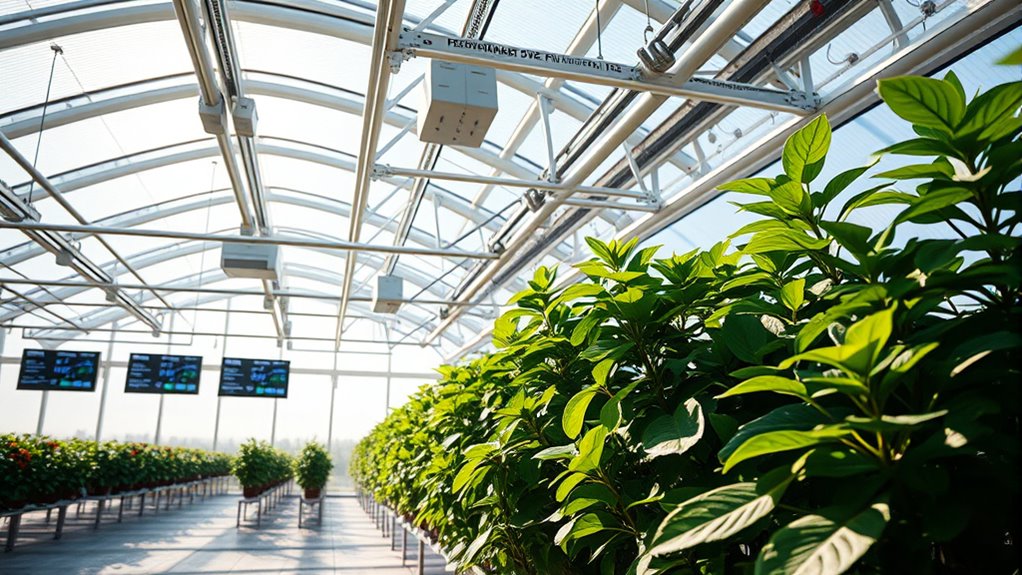
When you set up an automated climate control system for your greenhouse, you'll rely on several key components that work together to create the ideal growing environment. Sensors monitor essential factors like temperature, humidity, and CO2 levels, providing real-time data. Controllers act as the brain of the system, using this data to automate tasks effectively. The software centralizes control, enabling easy monitoring and adjustments. Actuators, such as fans, vents, and misting systems, carry out the commands issued by the controllers. Additionally, power management systems optimize energy use, ensuring efficiency. Together, these components create a seamless operation, maintaining the perfect conditions for your plants to thrive while also conserving resources. Fully automated systems offer the convenience of remote programming, further enhancing the control over the greenhouse environment.
Benefits of Precision and Consistency
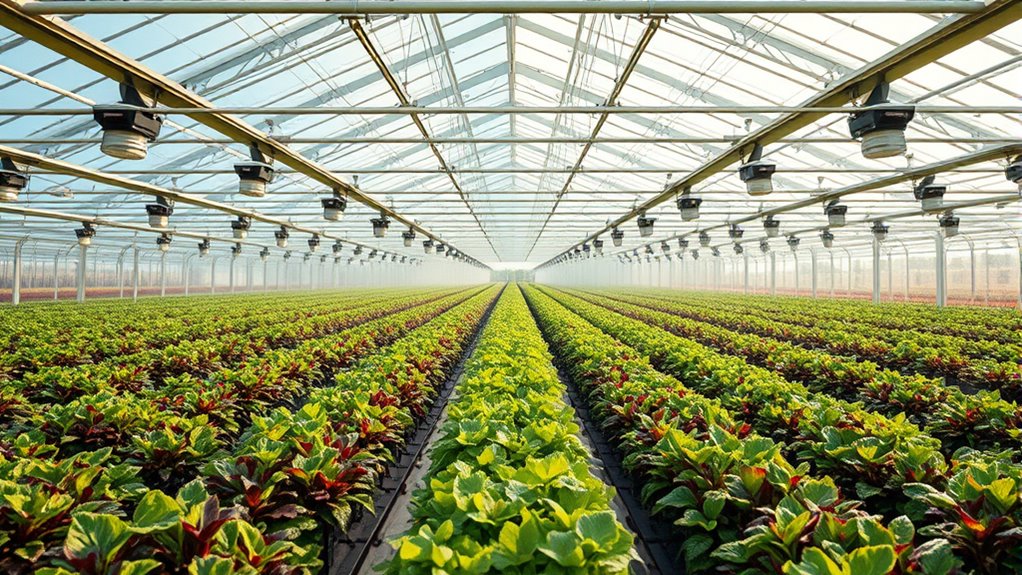
Precision and consistency in climate control significantly enhance greenhouse operations, ensuring your plants thrive in the best possible environment.
With accurate monitoring and automated adjustments, you eliminate human error, maintaining ideal conditions around the clock. This granular control means you can fine-tune temperature and humidity, creating a stable environment that reduces plant stress. Additionally, automated climate control ensures meticulous management of internal conditions, further supporting plant health. Furthermore, implementing energy-efficient systems in your greenhouse can lead to significant savings on operational costs.
As a result, your plants grow faster and healthier, producing higher yields and improved quality. Consistent conditions also bolster disease resistance, minimizing risks from pests.
By optimizing resource use and enhancing photosynthesis, you maximize productivity while lowering energy costs.
Time and Labor Efficiency Improvements
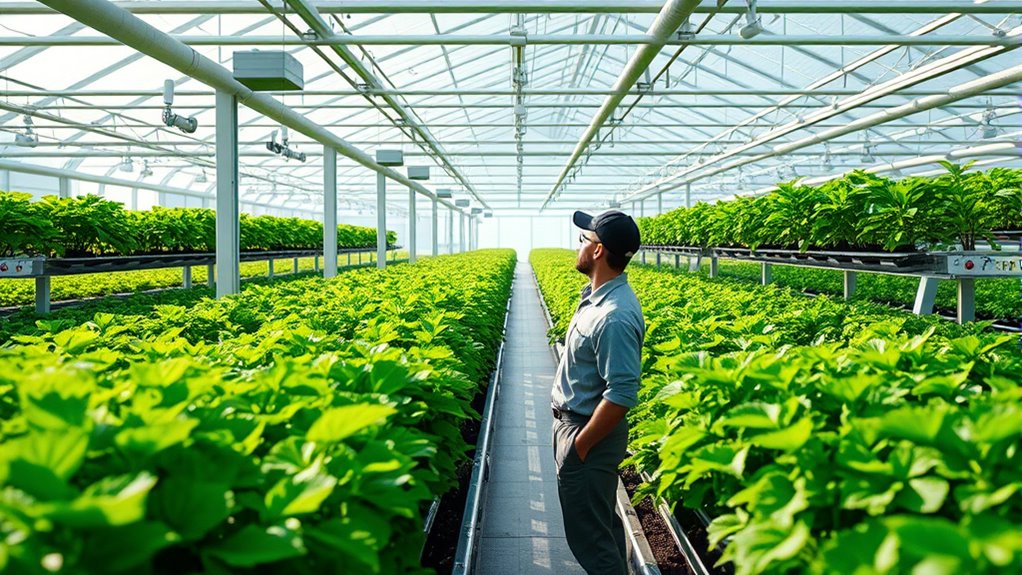
Automated climate control systems significantly boost time and labor efficiency in greenhouses, allowing you to focus on more strategic tasks. By reducing the need for manual adjustments, these systems free up your labor resources for higher-priority activities. With real-time monitoring, you can quickly identify and resolve issues, cutting down on troubleshooting time. The integration of various systems into a single platform simplifies operations and enhances management efficiency. Remote access lets you oversee greenhouse conditions without being physically present, maximizing your time. Plus, analyzing collected data helps you optimize future operations and further improve efficiency. Embracing automation means you'll streamline your processes and enhance productivity in your greenhouse, as automated systems provide precise management of environmental conditions.
Enhanced Plant Growth and Yields

By streamlining operations and maximizing efficiency, automated climate control systems set the stage for enhanced plant growth and increased yields. These systems maintain optimal temperature, humidity, and CO2 levels, which are essential for photosynthesis and overall plant health. With reduced stress from consistent conditions, plants develop better resistance to diseases, leading to healthier crops. Temperature and humidity regulation helps minimize fluctuations that can negatively impact growth, further supporting the health of the plants. Additionally, implementing solar-powered irrigation systems can further enhance crop yields by ensuring consistent watering while reducing energy costs. CO2 enrichment boosts photosynthesis rates significantly, while improved air circulation ensures uniform growth across all plants. You can achieve year-round production, regardless of external weather, and enjoy faster growth rates that translate to higher yields. Real-time monitoring allows for quick adjustments, optimizing conditions to enhance crop quality and market competitiveness, ultimately benefiting your greenhouse operation.
Energy and Resource Efficiency
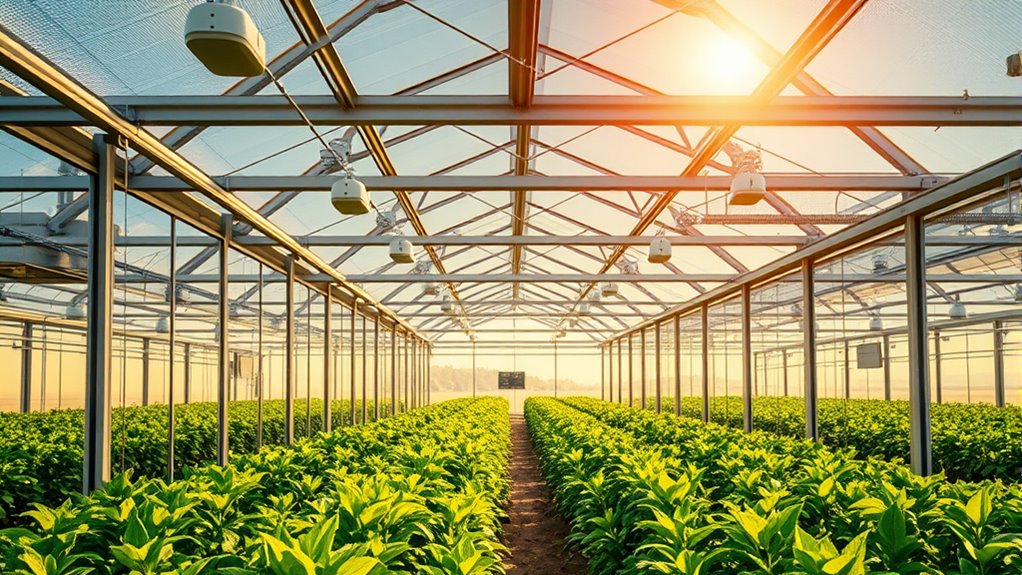
As you strive for greater energy and resource efficiency in your greenhouse operations, implementing advanced technologies can significantly reduce costs and environmental impact. Utilizing renewable energy sources like solar panels and wind turbines lowers your reliance on fossil fuels. Transitioning to renewable energy sources enhances energy efficiency in greenhouse operations, further supporting your sustainability goals. Thermal screens and proper insulation maintain stable temperatures, cutting down on heating and cooling needs. Automated climate control systems optimize energy use, ensuring resources are only utilized when necessary. With IoT devices and smart sensors, you can monitor conditions in real-time, allowing for precise adjustments. Efficient irrigation systems minimize water waste, while energy-efficient LED lighting reduces electricity consumption.
Advanced Features and Integration Options
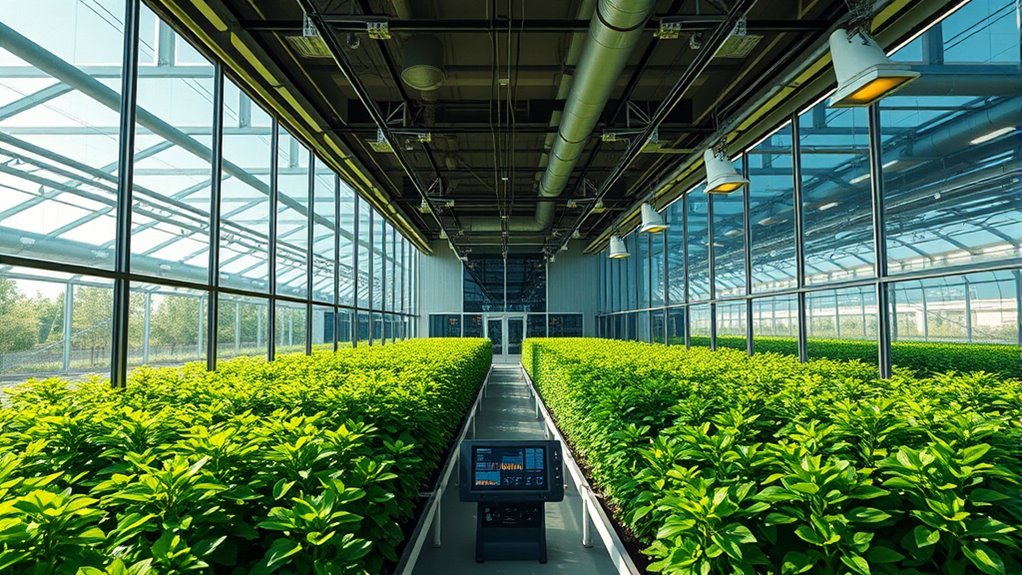
While managing a greenhouse, leveraging advanced features and integration options can greatly enhance your operational efficiency.
You can monitor real-time data on temperature, humidity, and CO2 levels through smart sensors, allowing for quick adjustments. Remote access via smartphones or computers helps you manage conditions from anywhere. Additionally, the real-time data access ensures that you can make informed decisions instantly, optimizing your greenhouse environment.
Automated adjustments ensure optimal environments based on external factors, while data analysis provides insights for improved practices.
Integrating HVAC systems, weather stations, and irrigation ensures seamless operation. Plus, modular designs let you scale your system as needed.
With centralized control and multi-zone management, you reduce labor and improve crop quality through data-driven decisions, ultimately maximizing your greenhouse's potential.
Embrace these technologies for a more efficient and productive growing experience.
Frequently Asked Questions
How Much Does an Automated Climate Control System Cost?
When considering an automated climate control system, you'll find costs can vary significantly based on the components you choose.
Basic digital thermostats might start around $26.95, while advanced environmental controllers can range from a few hundred to several thousand dollars.
Don't forget to factor in installation and ongoing energy costs.
Ultimately, your total investment will depend on the complexity and scale of the system you're looking to implement.
What Types of Sensors Are Commonly Used?
Think of sensors as the senses of your environment, helping you stay connected.
In your setup, you'll commonly find temperature sensors to monitor heat, humidity sensors for moisture control, and light sensors to adjust illumination.
CO2 sensors optimize photosynthesis, while soil moisture sensors help maintain optimal hydration.
You might also use weather sensors to track conditions and automation sensors to keep everything running smoothly.
Each sensor plays a vital role in your system's health.
Can I Install the System Myself?
Yes, you can install the system yourself if you've got basic electronics and programming skills.
You'll need microcontrollers, sensors, and actuators, along with some tools for assembly. While it can be time-consuming to set up and debug, the cost savings and customization options make it worthwhile.
Just keep in mind that you'll need to maintain the system regularly and ensure that all components are weather-resistant for optimal performance.
What Maintenance Is Required for These Systems?
You'll need to perform regular maintenance to keep your system running smoothly. This includes calibrating sensors to ensure accurate readings, checking hardware components like fans, and applying software updates for efficiency.
Don't forget about data analysis to spot issues early and schedule routine maintenance to prevent unexpected failures. Having a spare parts inventory can help minimize downtime during repairs, so you're always prepared for any technical challenges that may arise.
How Do I Choose the Right System for My Greenhouse?
Choosing the right system for your greenhouse is like picking the perfect outfit for a special occasion. You need to consider your crop requirements, layout, and budget.
Start by evaluating the automation level you need; a simple setup might suffice or you might want advanced features for efficiency.
Don't forget to think about future expansions. Ultimately, it's about finding a balance between functionality, cost, and adaptability to ensure your greenhouse thrives.
Conclusion
In wrapping up, automated climate control isn't just a luxury; it's the heartbeat of modern greenhouses. By embracing these systems, you're not only boosting plant growth and yields but also saving time and resources. With precision and consistency, your greenhouse can thrive like never before. So, why wait? Step into the future of agriculture and watch your plants flourish under the perfect conditions, turning your green dreams into a flourishing reality.
